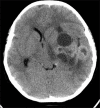High-grade astroblastoma in a child: Report of one case and review of literature
- PMID: 25101206
- PMCID: PMC4123262
- DOI: 10.4103/2152-7806.137532
High-grade astroblastoma in a child: Report of one case and review of literature
Abstract
Background: Astroblastoma is a rare glial neoplastic lesion that affects children and adolescents; its histogenesis remains uncertain. It is considered to account for 0.5% of all glial neoplasms, and two different subtypes have been defined based upon histologic characteristics.
Case description: We present the case of a 9-year-old girl who presented with headache, motor symptoms, and seizures few days before she was admitted to our institution. Computed tomography (CT) and magnetic resonance imaging (MRI) scans showed an intra-axial heterogeneous frontoparietal lesion with a striking "bubbly" appearance in MRI T2-weighted sequences and features of intracranial hypertension. Gross total resection of the tumor was achieved and the histopathologic diagnosis revealed high-grade astroblastoma. We reviewed the current published cases of astroblastoma to highlight the demographic, clinical, radiologic, and pathologic data.
Conclusion: Astroblastomas are a distinct clinicopathologic entity, with well-described radiologic, pathologic, and cytogenetic features. Its recurrence is high and efforts must be made to elucidate the role and usefulness of radiotherapy and chemotherapy in these tumors.
Keywords: Astroblastoma; glial tumors; pediatric tumors; supratentorial tumor.
Figures




References
-
- Alaraj A, Chan M, Oh S, Michals E, Valyi-Nagy T, Hersonsky T. Astroblastoma presenting with intracerebral hemorrhage misdiagnosed as dural arteriovenous fistula: Review of a rare entity. Surg Neurol. 2007;67:308–13. - PubMed
-
- Bailey P, Bucy PC. Astroblastomas of the brain. Acta Psychiat Neurol. 1930;5:439–61.
-
- Bailey P, Cushing H. Philadelphia: JB Lippincott; 1926. A classification of the tumors of the gliomas group on a histogenic basis with a correlation study of prognosis.
-
- Bell JW, Osborn AG, Salzman KL, Blaser SI, Jones BV, Chin SS. Neuroradiologic characteristics of astroblastoma. Neuroradiology. 2007;49:203–9. - PubMed
-
- Bonnin JM, Rubinstein LJ. Astroblastomas: A pathological study of 23 tumors, with a postoperative follow-up in 13 patients. Neurosurgery. 1989;25:6–13. - PubMed
Publication types
LinkOut - more resources
Full Text Sources
Other Literature Sources

